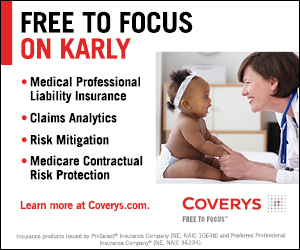A burned-out primary care physician once said, “Working at Starbucks would be better.” Four years later, that same physician said, “I look forward to going to work each day. I’m loving it!”1 How is this possible?
Our professional healthcare landscape has been charred by burnout. Fortunately, we now know how to redesign our practices to restore professional fulfillment and protect patient safety.
Prevalence of Burnout
When we at the American Medical Association (AMA) completed our first survey in 2011, burnout rates were already approaching 50%. In 2021, the second year of the pandemic, our fifth national survey found that burnout had reached the highest level in this series at 63%. In COVID-facing specialties such as emergency medicine, burnout rates approached 80% (Shanafelt, et al., Mayo Clinic Proceedings, in press). We don’t need to fix the worker. We need to fix the workplace.
Work Domain
With the EHR, as many of us have experienced, various tasks that were previously completed by the receptionist, pharmacist, or transcriptionist all suddenly became the work domain of the physician. But it doesn’t have to be this way. Some researchers have found that 50% of a physician’s workday is spent on the EHR, and two-thirds of that time is spent on work that does not need a medical school education—such as order entry, billing, coding, documentation, and processing refills.2 Most of that work can be done by a team.
Yet, too many physicians shoulder this load alone. The expression goes that people don’t leave their jobs, they leave their bosses. Likewise, physicians don’t leave their patients, they leave their inboxes. This is because the inbox has become unmanageable.3
While burnout manifests in individuals, it originates in systems, so we must implement systemic changes to protect ourselves and our patients.
Consequences of Burnout
If we care about patient safety and the sustainability of our healthcare institutions, we must also care about burnout. We know that when we are burned out, we are twice as likely to make mistakes—which means higher rates of malpractice. For physicians, add personal consequences such as higher rates of disease, substance abuse, divorce, and death by a variety of means.4
Fortunately, feeling valued has proved to be protective against both burnout and intention to leave.5 This is not a feeling generated by an ice cream bar or muffins, but rather by substantial reflections of value that affect an individual’s daily work, such as preparing them with personal protective equipment, training, and support.
Professional Fulfillment
Professional fulfillment, the inverse of burnout, is driven by three factors:
- Organizational culture.
- Practice efficiency.
- Personal resilience.
This trio has been identified by the Stanford WellMD model.6 I would like to showcase two types of change that have an impact on practice efficiency and are readily accessible to many individuals and organizations.
1. De-Implementing Administrative Burdens
At the AMA, we have created the Joy in Medicine™ Health System Recognition Program,7 which provides a roadmap for organizations to improve professional satisfaction. One of our recommended leadership actions is to appoint someone to begin de-implementing unnecessary administrative burdens.
Our de-implementation checklist, which is available to all, is aligned with The Joint Commission’s standards. One checklist item is to decrease password revalidation requirements.
In-Practice Example: The chief wellness officer of a major healthcare system emailed me recently to say how excited she was about the de-implementation of burdensome administrative steps, including no longer requiring password revalidation for medication changes. She said, “My neck is no longer sore from doing the badge login. I’m no longer doing as many username and password entrances.” Her organization calculated that they affected 1.5 billion orders per week by de-implementing these requirements for repetitive reentry.
2. Practice Models
At the AMA, we have created a wealth of resources for increasing practice efficiency and recovering clinician time.8 We’ve created over 75 practical, actionable toolkits, as well as playbooks, webinars, and podcasts. These tools illuminate accessible action items, like flagging what simply should not enter a clinician’s inbox. Organizations can choose to reroute cluttering items, like patient event notifications, and preserve the clinician’s attention for higher-priority items.
We also advocate for practice models with built-in support. The least functional model is the doctor-does-it-all model. If we can support physicians to allow them to give their undivided attention to their patients, not the computer, outcomes are better for patients, physicians, and organization finances.
In-Practice Example: A Wisconsin accountable care organization (ACO) piloted an advanced team-based care model by assigning two upskilled medical assistants per physician. Those physicians saw improvements in performance and quality measures and increased likelihood that the patient would recommend the physician to others. They also increased revenue to the ACO by closing more care gaps.
Quadruple Aim Reframed Catherine Lucey, MD (of the University of California, San Francisco, and a former Chair of the American Board of Internal Medicine), restated the quadruple aim this way: “Care better than we’ve ever seen, health better than we’ve ever known, cost we can all afford, delivered by professionals who find joy in their work as they commit to serve others.” That’s a vision I can sign up for—and it is a vision I believe we can come closer to meeting.













